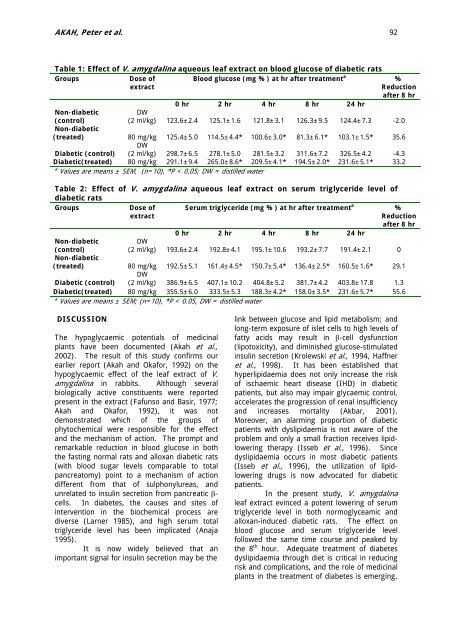ARI Volume 1 Number 2.pdf - Zoology and Environmental Biology ...
ARI Volume 1 Number 2.pdf - Zoology and Environmental Biology ...
ARI Volume 1 Number 2.pdf - Zoology and Environmental Biology ...
You also want an ePaper? Increase the reach of your titles
YUMPU automatically turns print PDFs into web optimized ePapers that Google loves.
AKAH, Peter et al. 92<br />
Table 1: Effect of V. amygdalina aqueous leaf extract on blood glucose of diabetic rats<br />
Groups Dose of<br />
Blood glucose (mg %) at hr after treatment<br />
extract<br />
a<br />
%<br />
Reduction<br />
after 8 hr<br />
0 hr 2 hr 4 hr 8 hr 24 hr<br />
Non-diabetic<br />
DW<br />
(control)<br />
Non-diabetic<br />
(2 ml/kg) 123.6±2.4 125.1±1.6 121.8±3.1 126.3±9.5 124.4±7.3 -2.0<br />
(treated)<br />
80 mg/kg<br />
DW<br />
125.4±5.0 114.5±4.4* 100.6±3.0* 81.3±6.1* 103.1±1.5* 35.6<br />
Diabetic (control) (2 ml/kg) 298.7±6.5 278.1±5.0 281.5±3.2 311.6±7.2 326.5±4.2 -4.3<br />
Diabetic(treated) 80 mg/kg 291.1±9.4 265.0±8.6* 209.5±4.1* 194.5±2.0* 231.6±5.1* 33.2<br />
a<br />
Values are means ± SEM, (n=10), *P < 0.05; DW = distilled water<br />
Table 2: Effect of V. amygdalina aqueous leaf extract on serum triglyceride level of<br />
diabetic rats<br />
Groups Dose of<br />
extract<br />
Serum triglyceride (mg %) at hr after treatment a<br />
%<br />
Reduction<br />
after 8 hr<br />
0 hr 2 hr 4 hr 8 hr 24 hr<br />
Non-diabetic<br />
DW<br />
(control)<br />
Non-diabetic<br />
(2 ml/kg) 193.6±2.4 192.8±4.1 195.1±10.6 193.2±7.7 191.4±2.1 0<br />
(treated)<br />
80 mg/kg<br />
DW<br />
192.5±5.1 161.4±4.5* 150.7±5.4* 136.4±2.5* 160.5±1.6* 29.1<br />
Diabetic (control) (2 ml/kg) 386.9±6.5 407.1±10.2 404.8±5.2 381.7±4.2 403.8±17.8 1.3<br />
Diabetic(treated) 80 mg/kg 355.5±6.0 333.5±5.3 188.3±4.2* 158.0±3.5* 231.6±5.7* 55.6<br />
a<br />
Values are means ± SEM; (n=10), *P < 0.05, DW = distilled water<br />
DISCUSSION<br />
The hypoglycaemic potentials of medicinal<br />
plants have been documented (Akah et al.,<br />
2002). The result of this study confirms our<br />
earlier report (Akah <strong>and</strong> Okafor, 1992) on the<br />
hypoglycaemic effect of the leaf extract of V.<br />
amygdalina in rabbits. Although several<br />
biologically active constituents were reported<br />
present in the extract (Fafunso <strong>and</strong> Basir, 1977;<br />
Akah <strong>and</strong> Okafor, 1992), it was not<br />
demonstrated which of the groups of<br />
phytochemical were responsible for the effect<br />
<strong>and</strong> the mechanism of action. The prompt <strong>and</strong><br />
remarkable reduction in blood glucose in both<br />
the fasting normal rats <strong>and</strong> alloxan diabetic rats<br />
(with blood sugar levels comparable to total<br />
pancreatomy) point to a mechanism of action<br />
different from that of sulphonylureas, <strong>and</strong><br />
unrelated to insulin secretion from pancreatic βcells.<br />
In diabetes, the causes <strong>and</strong> sites of<br />
intervention in the biochemical process are<br />
diverse (Larner 1985), <strong>and</strong> high serum total<br />
triglyceride level has been implicated (Anaja<br />
1995).<br />
It is now widely believed that an<br />
important signal for insulin secretion may be the<br />
link between glucose <strong>and</strong> lipid metabolism; <strong>and</strong><br />
long-term exposure of islet cells to high levels of<br />
fatty acids may result in β-cell dysfunction<br />
(lipotoxicity), <strong>and</strong> diminished glucose-stimulated<br />
insulin secretion (Krolewski et al., 1994, Haffner<br />
et al., 1998). It has been established that<br />
hyperlipidaemia does not only increase the risk<br />
of ischaemic heart disease (IHD) in diabetic<br />
patients, but also may impair glycaemic control,<br />
accelerates the progression of renal insufficiency<br />
<strong>and</strong> increases mortality (Akbar, 2001).<br />
Moreover, an alarming proportion of diabetic<br />
patients with dyslipidaemia is not aware of the<br />
problem <strong>and</strong> only a small fraction receives lipidlowering<br />
therapy (Isseb et al., 1996). Since<br />
dyslipidaemia occurs in most diabetic patients<br />
(Isseb et al., 1996), the utilization of lipidlowering<br />
drugs is now advocated for diabetic<br />
patients.<br />
In the present study, V. amygdalina<br />
leaf extract evinced a potent lowering of serum<br />
triglyceride level in both normoglyceamic <strong>and</strong><br />
alloxan-induced diabetic rats. The effect on<br />
blood glucose <strong>and</strong> serum triglyceride level<br />
followed the same time course <strong>and</strong> peaked by<br />
the 8 th hour. Adequate treatment of diabetes<br />
dyslipidaemia through diet is critical in reducing<br />
risk <strong>and</strong> complications, <strong>and</strong> the role of medicinal<br />
plants in the treatment of diabetes is emerging.

















